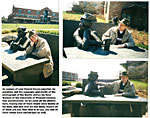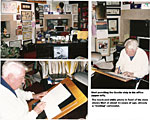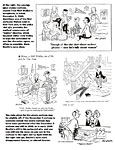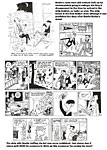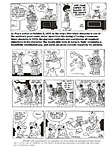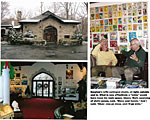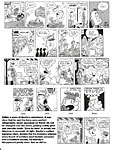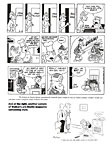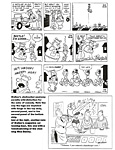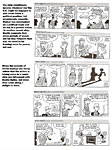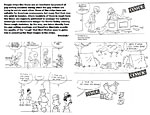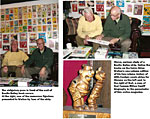BEETLE
BAILEY GOES BEETLING ON, FIFTY-EIGHT AND COUNTING When
I said I wanted to watch him draw a strip, Mort Walker said, “Sure,”
and we got up from the conversation pit where we had been seated in
front of the massive fireplace in what had once been the studio of
Gutzon Borglum, sculptor of Mount Rushmore, and walked into Mort’s
office around the corner from the stairway leading to the loft
overhead where Mort’s assistant Bill Janocha labors daily. Mort
had finished penciling his regular weekly batch of strips the day
before—Monday, daily strip drawing day—but he sat at his
desk and pulled out another rough to convert to a finished pencil for
my benefit. He put a small drawing board, maybe eighteen by
twenty-four inches, in his lap and tilted it, propping it against the
desk, then picked up two pieces of artboard. He placed the smaller
5x17-inch piece on top of the larger sheet and, taking a mechanical
drafting pencil in hand, he drew it along all four edges of the
smaller rectangle, penciling the border of a strip on the artboard
beneath. On the artboard with the template still in place, he marked
the middle of the strip—where it would be divided into two
panels—put the template aside, placed the rough rendering of
the strip on the upper edge of the drawing board, and looked at his
watch. Then he began to draw the first of the two panels, copying the
compositions in the rough. The day’s gag, roughed in a clean pencil sketch on 8.5x11-inch foolscap, featured only Beetle and Sarge: Sage, seated at his desk, hands Beetle an envelope and tells him to deliver it, and Beetle promptly sits down, leaning against the wall. “What are you doing?” Sarge yells. Beetle says: “I never do any work without goofing off first.” Mort quickly sketched very lightly two circles to position the characters’ heads in the first panel, then he indicated their bodies’ positions with a couple outlining lines each. His blocking of the panel’s composition now consisted of two wraith-like apparitions, barely visible, entirely featureless like snowmen. Next, he lettered the speeches of the characters and drew the speech balloons. Then he turned to Sarge and, drawing a small rectangle on top of the head circle, he located Sarge’s garrison cap on his head, then drew the characteristic four-lumps that finish the abstraction of the character’s customary headgear. He then drew Sarge’s eyes, focused on the desk in front of him, then a round ball for Sarge’s nose. He drew Sarge’s body, seated at his desk, and the extended arm and hand giving Beetle an envelope. Next he drew another rectangle, somewhat boxier, squarer, than Sarge’s, on Beetle’s head, adding a pointed bill to complete the fatigue cap Beetle usually wears. Then he put a perfectly round shape under the bill for Beetle’s nose. Beetle’s eyes, as usual, do not appear, obscured for evermore under the bill of the cap. After giving Beetle a body and tubular legs and arms, Mort went on to the second panel. Every
line Mort drew was exactly, perfectly, placed: none of the lines were
sketchy, trial-and-error lines searching for the correct position.
Sarge, the desk, and Beetle were each outlined with single strokes.
When Mort’s son Greg inked the strip, he wouldn’t have to
choose which lines to ink: there was only one in every instance. Mort
had been drawing Beetle and his compatriots for nearly sixty years:
he didn’t have to guess about where the lines went; he didn’t
have to search for their positions. ***** In the world of newspaper comics in the fall of 1950, two watershed events began a trickle-down of consequences that would one day divide all that went before from what was yet to come. The first of these events that history and hindsight invest with portent occurred on September 4: on that date, a comic strip by Mort Walker called Beetle Bailey began its run. It appeared in only twelve papers, a painfully inauspicious beginning. And its circulation didn't improve much over the next six months. By the end of February 1951, it claimed only 25 subscribing papers. But in the fullness of time, Beetle Bailey would become the third most widely distributed comic strip in history. The perennial Blondie would rank second, and first place would go to the other strip the debut of which marked the fall of 1950 as a turning point in the history of the medium—Peanuts. Charles Schulz's colossally successfully strip about introspective "li'l folks" (his original title for the strip) had an even more unspectacular start than Beetle Bailey: only seven papers ran the earliest strips, beginning October 2. And its circulation was still well under 100 papers a year later. But within the decade, it would become one of the nation's most popular comics. Schulz's strip would revolutionize comic strip art: his deceptively simple drawing style set a new fashion for newspaper cartoonists. And Walker's equally simple but geometrically distinctive style would give cartoonists another model on the funny pages of the coming decades. But the milestone marked by the launching of these two strips had more to do with content than with drawing styles. Both strips told jokes not stories. They ended each installment with a punchline. Although a week's run of strips might have a common theme, there was no storyline. With the success of Walker and Schulz and their imitators and of others like Hank Ketcham, whose gag panel cartoon Dennis the Menace began March 12, 1951 (and was immediately a smash hit), the humorous function of cartooning would emerge during the fifties into pace-setting popularity once again after a quarter-of-a-century hiatus throughout which story strips had held nearly absolute sway. In the autumn of 1950, though, continuity strips still reigned supreme. Four of the top five strips (according to Time) were story strips—Little Orphan Annie, Dick Tracy, Joe Palooka, and Li'l Abner. Only Blondie relentlessly told a joke every day. And six of the ten strips that ranked highest with the readers of The Saturday Review of Literature were continuities—Li'l Abner, Gasoline Alley, Dick Tracy, Steve Canyon, Pogo, and Terry and the Pirates. Li'l Abner and Pogo were humorous continuities, to be sure, but the fullest understanding of their humor depended upon following the strips day-by-day. The only strictly humorous strips to finish in the Review's top ten were Blondie (at the top of the list), Penny, Gordo, and Moon Mullins. But that would change. By the end of the decade, story strips were virtually swept off the comics pages by a deluge of their chortling brethren. But it wasn't fratricide: story strips weren't done in by gag strips. The culprit was in that box in the livingroom. Television, which could be seen coast-to-coast by the mid-fifties, displaced radio and the daily newspaper as the nation's source of entertainment in the home. Newspaper editors were desperate to preserve some remnant of their former hold upon the American public. First they fought television, refusing to give up space for any coverage beyond the most cryptic program listings. But when they saw that stories about television increased their readership and circulation, they devoted more space to TV news. Elsewhere in the paper, they sought to provide features and services that readers could not find in their TV sets. And when it came to the funnies page, the continuity strips were immediately singled out. Why would people read a story strip which takes two or three months to tell its tale when they can see an entire adventure in a hour on television? Editors stopped buying story strips; syndicates stopped buying them. They all bought gag strips instead (conveniently ignoring the fact that you can get more laughs in a half hour watching TV than you are likely to get in the ten minutes it takes to read the funnies every day). Thus, gag strips were the de facto beneficiaries of the television age, inheriting the newspaper space once occupied by epic continuities. It was the immense success of Beetle Bailey and Peanuts that showed cartoonists how to survive the advent of television. At the same time, the arrival of these strips in the fall of 1950 signaled the beginning of the end for story strips. But no one realized it at the time. At the time, as we've observed, these new strips slipped into public view virtually unheralded. When Mort Walker submitted his comic strip to King Features, he was editing a couple anthology magazines of single-panel gag cartoons and prose jokes for Dell (1,000 Jokes, for instance). Born in 1923, he had always wanted to be a cartoonist: he’d drawn cartoons all his life. He’d published his first cartoon when he was eleven years old, and by the next year, he’d started selling cartoons to magazines. At the age of 15, he was drawing a weekly comic strip for a newspaper in his hometown, Kansas City, Missouri. In 1948, he moved to New York City and started making the rounds every Wednesday to magazine cartoon editors’ offices; after an initial dry spell of a couple months, he was selling regularly to The Saturday Evening Post, Collier’s, The Saturday Review of Literature, and others. And in 1949, he had been proclaimed the top-selling magazine cartoonist in the country. According to a survey "someone" had conducted, he sold more gag cartoons than any of his fellows that year. It was, Walker realized, an empty triumph. He made only $7,500 that year. As his wife put it, "If you're the top seller and that's all you're making, then it must be a bad business." Knowing there was more real money to be made in syndication to newspapers than in gag cartoons for magazines, Walker decided to try to sell a comic strip to a feature syndicate. He had tried once before—while still in high school—without luck, but this time, following the advice of John Bailey, cartoon editor for The Saturday Evening Post, he focused on something he knew well—college life. Bailey had liked a funny-looking character Walker had pencilled into several of his cartoons—a lazy, lanky college kid who wore his hat down over his eyes; and Walker had done several cartoons featuring the kid, whom they called "Spider." Now Walker picked Spider to star in his comic strip. For situations and gags, he drew upon his experiences at the University of Missouri, from whence, after getting out of the Army at the end of World War II, he had graduated with a degree in journalism in 1948. He surrounded Spider with eccentric professors and even odder classmates. And he gave Spider a mission: the kid became a champion goof-off, forever shirking studies and responsibility. King Features bought the strip (it would be the last comic strip personally approved by William Randolph Hearst before he died in 1951), but since another feature bore the name "Spider," they re-named Walker's protagonist "Beetle" (and for the sake of euphony, Walker gave him a last name by which he thanked John Bailey for his good advice). The feature was forthwith catapulted into the world of newspaper comics, but nobody heard a splash.
After about six months, the silence was deafening. Walker didn't know it at the time, but King was thinking of dropping the strip. Then inspiration struck. The Korean War had been going on since the previous summer, and since men of Beetle's vintage were being called up left and right, it seemed logical to take the kid out of college and put him in uniform. So Walker did just that—on March 13, 1951. And 100 papers picked up the strip. The potential readership for a strip about Army life was enormous. Every able-bodied American male had been in miliary service or was in military service or would be in military service. Military experience was the great common bond. And again, Walker drew upon his own experience: he had been drafted in 1942 after one semester at the University of Missouri. The Army shuttled him around to an assortment of military training schools and finally settled him at Washington University in St. Louis where he earned a two-year diploma in basic engineering. Then, with the sort of logic for which the military mind is celebrated across the breadth and width of the known universe, the Army assigned Walker to the infantry and sent him overseas where he was put in charge of 10,000 German POWs who were disposing of the inventory of a supply depot in Italy, where, by then, the War was over. The Army was clearly lining itself up as a target for the would-be cartoonist's shafts. And when Beetle enlisted, Walker opened fire. Beetle would never see action on the battlefield. There was nothing funny about that. But at the training command of Camp Swampy, there was plenty to laugh at. And an entire nation joined Walker in the laughter. The strip's next growth spurt occurred when the Far East edition of The Stars and Stripes "banned" Beetle in January 1954. The Army brass said the strip was bad for morale and gave the public an unfavorable impression of the Army because it made fun of officers. The ban lasted for 10 years, but the rumpus it raised (egged on by Syndicate publicity manufactured at Walker's urging) inspired another 100 newspapers to buy the strip, bringing Beetle's circulation to around 300. For many years, the Army remained a little piqued about the way it was portrayed in the strip, but it eventually changed its so-called mind: in May 2000, it called Walker to the Pentagon and presented the cartoonist with the Decoration for Distinguished Civilian Service, the highest award the Secretary of the Army can bestow upon a civilian. The strip hit 500 in 1956, and it was the second strip in history to pass the 1,000 mark in 1965. (Until then, only Blondie appeared in more than 1,000 papers.) Five years later, Beetle was in nearly 1,400 papers. And by the mid-1980s, according to Editor & Publisher (March 3, 1984), the strip was in 1,660 papers (ranking third behind Peanuts with 1,941 and Blondie with 1,900; before the end of the decade, Jim Davis’ strip about a fat cat, Garfield, would come in second behind Peanuts, displacing both Blondie and Beetle Bailey). Although the military setting provides the initial attraction by which readers are lured into Walker's comedic clutches, Beetle Bailey is a strip driven by the personalities of its characters not its situation. Writing in The Best of Beetle Bailey in 1984, Walker observed that Beetle's cast is larger than that of any other strip (with the exception of Pogo). As he reviewed thirty years of the strip, Walker paused to comment about his principals. About Sergeant Orville P. Snorkel, Walker wrote: "Sarge is probably my favorite character to draw. Not only does he look funny in all positions, but he takes up a lot of space which saves me from drawing a lot of backgrounds. He's garrulous, profane, ecstatic, rough, sentimental, voracious. ... He does everything to the extremes. ... Top sergeants have been called the backbone of the Army. Most GI's refer to them as a lower part of the anatomy. ... Most of them are career Army types who are so immersed in military life, they think a civilian is a soldier in drag. Sgt. Snorkel is the epitome of that breed." Zero: "We all know someone like Zero who isn't quite with it. His name is a clue to his IQ. But he's not really as mentally deficient as he is uninformed. ... Zero couldn't be in the Army if he were retarded. He's just an innocent young farm boy as sweet, honest and unsophisticated as an ear of corn." General Amos T. Halftrack: "Halftrack is what every GI knows a general is: he's lousy at running the camp and when he gets home his wife runs him. ... As a leader, General Halftrack couldn't lead a cub scout to a candy store, but he's one of my favorite characters." Apart from the voluptuous Miss Buxley (who inspired charges of sexism), Lt. Flap was the most controversial of Walker's characters. Walker had wanted to bring a black into the strip for years. "Trouble was, if I made him a lazy goof-off like the regular cast, I'd get complaints." All the Beetle characters were objects of laughter, and a black as fall guy might be offensive. Walker put the idea on a back burner. And then in the middle of the night one night, Flap came to him—"with his Afro, goatee, and jaunty manner. It was as though he'd always been there." Walker's assistants were divided about introducing Flap. Half thought he was a good character. The other half wondered why the circulation of the strip should be risked. "Why do it? You don't need to." "I felt I had to do it for the sake of honesty, if nothing else," Walker explained. "The Army had been integrated for years. Blacks exist. Beetle Bailey's army was a phony [without blacks]. I was a coward if I didn't try it. The trick was to do an honest job of it, come up with a character that was not offensive yet was as funny as the rest of my characters. Making Flap a lieutenant gave him some status and power, and I would base his humor on his firm stand of being accepted as a man."7 The syndicate hesitated but finally gave approval, and Lt. Flap debuted on October 5, 1970—shouting at Sarge, "How come there are no blacks in this honky outfit?" "Help," squeeked Snorkel. Walker introduced his new character by confronting and overwhelming all the attendant problems at once. Stars and Stripes banned Beetle again because it thought the strip would cause racial tension, but Senator Proxmire convinced the brass to reinstate the world's most famous private. Elsewhere, Beetle picked up 100 additional papers over the next 12 months. Surprisingly in a strip with so large a cast, Beetle is still the star. The personality of the title character in populous strips often fades away, eroded by the attention given to other characters, no doubt. But Beetle's quirks are as pronounced today as ever—and as central to much of the strip's humor. "He subscribes to the philosophy, ‘Whenever the urge to work comes over me, I lie down until it goes away,'" Walker once noted. Consequently, when Beetle enlisted, "he was rapidly assimilated into Army life. Instead of dorm matters, he simply switched to barracks buddies. Instead of professors who gave him trouble, he had sergeants. Instead of institutional food in the cafeteria, he got his heartburn in the mess hall. He fell right into it—especially the bed." But Beetle Bailey is not really a strip about Army life. Says Walker: "The truth is, it's just a strip about a bunch of funny guys. They could be policemen, factory workers, college students, whatever. The Army is just a convenient setting that everyone understands. The pecking order doesn't have to be explained, and the role of the poor guy at the bottom of the ladder is a classic in literature." Sociologists who have studied the strip for the way it represents authority are close to the heart of the matter. Walker's army is simply a version of society, which sustains its essential order through a hierarchy of authority. From the point of view of most of us in a social order, the flaws in the system are due to the incompetence of those who have authority over us. Beetle Bailey encapsulates this aspect of the human condition and gives expression to our resentment of authority by ridiculing traditional authority figures. But the ridicule is gentle: it takes shape as Walker repeatedly shows us that everyone in his army—authority figure or not—is but a bundle of personality quirks. Hence, the strip is a great leveler: we're all equal. Everyone has his frailties, his entirely human foibles. In his book, Backstage at the Strips (still probably the best book around about the life of a cartoonist), Walker discussed his attitude towards humor. He disagreed with Jules Feiffer, who, he said, believes "you have to hate to be funny. Humor, Feiffer says, comes from dissatisfaction with things; you attack, ridicule, and destroy what you don't like with humor." Some humorists do. But Walker said he's more comfortable with Leo Rosten's notion that "humor is an affectionate insight into the affairs of man." "Affectionate is the word that won me," Walker explained. "I like people. I like their absurdities, their aberrations, their pretensions. If you catch a guy exaggerating, you don't ridicule him: you understand him." Walker's strip is, indeed, just about "a bunch of funny guys." All of us. And that is the universal appeal of the strip—its foundation on the fundamentally human condition. In the early years, a large proportion of the gags were built on Army customs, duties, and regulations. But the longer the strip lasted—and the greater its circulation grew—the more the gags sprang from the personalities of the characters rather than the institutions of the Army. It was a wholly natural development, the outcome we would expect in a strip with a large cast. As the Army as an institution faded away, the common condition of humanity remained, and the strip thus established its universality. For the student of comic strip art, Beetle Bailey is something more than a strip with universal appeal. Although Walker's accomplishments were recognized by his peers as early as 1954 when the National Cartoonists Society gave him a Reuben as Cartoonist of the Year 1953, he has, oddly, never been credited enough in critical circles for his complete mastery of the medium. And his is scarcely an unconscious talent. "An editor told me a long time ago," Walker once said, "that if you could cover up the drawing and still get the gag by reading the caption, then you were a writer and not a cartoonist. With that advice, I've always tried to get as many funny pictures into my work as possible." To a greater extent than many of his more trendy contemporaries—Johnny Hart, Brant Parker, Jeff MacNelly, Gary Trudeau (and a flock of the latter's imitators)—Walker and his crew of assistants make the humor in Beetle visual as well as verbal. To understand the joke, we must grasp the implications of the pictures as well as the meaning of the words. In blending the verbal and the visual, Walker is firmly in the tradition of comic strip art at its finest, using the resources of the medium to their fullest. In visual terms alone, Beetle achieves a highwater mark in the art of cartooning. Over the years, Walker's style has evolved. At first, he drew in a simple bigfoot style that seemed a mix of John Gallagher and Tom Henderson, two great magazine cartoonists of the fifties. (Walker says his style was absorbed from Frank Willard, Walter Brendt, Chic Young, Milton Caniff, and Al Capp; so what do I know? Just that where there's smoke, there's something to make your eyes smart.) But as the years rolled by, Walker refined his style, streamlining simplicity into a unique comic abbreviation. Some simplification was required to meet necessity. As strips were reproduced smaller and smaller, Walker stopped drawing elaborate crowd scenes. And he stopped using Benday gray tones to shade uniforms and began relying entirely on judicious spotting of solid blacks for visual variety in his strip. (The drab, monotonous setting of Army life still bothers Walker, and he continually struggles to insinuate telling graphic contrasts into each daily installment.) Walker shrank his figures to fit the smaller panels. Heads stayed about the same size, though, so the proportions changed: heads became larger in relation to bodies than they had been in the fifties. One effect was to make his people cuter. At the same time, everything—heads, noses, bodies, hands, fingers—got rounder. Sarge got rounder and fatter as he grew shorter, finally becoming cuddly (a dubious trait for the top sergeant of tradition, but with Sarge, it works). By the late fifties and early sixties, Walker's patented stylized forms had emerged. Not since Cliff Sterrett surrealized human anatomy in the futuristic manner have we had such charming comic abstractions of the human form. The simplest shapes suggest human dimensions. Beetle's head is a cantaloupe; Sarge's, a giant pear. Upon these pulpy craniums, Walker's grafts billiard balls for noses. Bodies in repose hang limply from these heads like uninhabited suits of clothes weighted to the ground by monster shoes (not feet), and hands are doughy wads, dangling at the ends of empty sleeves. Clothing shows no wrinkles: sleeves and pantlegs are simple geometric shapes vaguely approximating arms and legs. Anatomy
is wonderfully elastic in Walker's hands. A bent arm or leg is
longer than when the limb is straight (you need length to show a
bend). The illusion of the body in motion is achieved by means of a
carefully orchestrated series of wild distortions. A person walking
has only one leg—the one in front, which trails a second foot
behind as if it were growing out of the lead leg's ankle. Running
figures are all elbows and knees, perfect comic abstractions. The
flexibility of Walker's abstracted simplicity is capable of extreme
exaggeration for comic effect. Indeed, much of the humor in many
strips arises from the antic visuals as much as from the situation
depicted. If I were in a poetic mood, I'd be tempted to say that Walker's style evolved to suit his subject. His representations of humanity are as abstracted as his microcosm of society. But that's poetry not fact. Nice, but it reaches a little. The fact is that the drawings are the way they are so that the visuals will be funny. The pictures help the words achieve comedy by blending the visual and the verbal. But the pictures are comic in themselves, too, art works of hilarious imagery. Walker has always appreciated the artistry of cartooning, but it wasn’t until he and Dik Browne went to Jamaica in 1960 for a cartoonists’ golf tournament that he decided to go public with his conviction. According to the legend surrounding the historic moment, Walker turned to Browne as they were celebrating over adult beverages in the club and said: “Why don’t cartoonists get more respect?” Browne was always quick with a response to any provocation, and he didn’t fail on this occasion: “Because museums don’t exhibit cartoons,” he reposited. Said Walker: “Let’s start a museum then.” And he did. The Musuem of Cartoon Art was established in 1973, and shortly thereafter, Walker mounted the embryo collection in a converted mansion not far from his home and studio in Greenwich, Connecticut. Opening August 11, 1974, it was the first museum dedicated to collecting and exhibiting cartoons. Two years later, the landlord yanked the lease, and the MCA relocated to a more picturesque venue, a renovated concrete castle in Rye Brook, New York, where the collection was displayed until 1992. About that time, the castle, which had been built by the man who invented reinforced concrete, began falling down; its concrete was not, oddly, reinforced, and pieces of it were liable to fall on innocent passersby. Walker went looking for another location for the Museum, and the city of Boca Raton, Florida invited the Museum to construct a 52,000 square-foot facility there as part of an effort to attract cultural institutions to an upscale shopping mall. The brand new Boca Raton building, designed expressly to house a museum of cartoon art, opened in 1996 with the re-christened International Museum of Cartoon Art. Although a popular attraction with acclaimed exhibits, events and functions for the public, when two of its financial backers went bankrupt a few years later, IMCA sold its building to pay off its debts, and Walker again went looking for a home for the collection. For a short while in 2006, plans were actively underway to raise money to convert facilities on the ground floor of the Empire State Building in mid-town Manhattan, ideally located for attracting casual walk-in traffic. But those plans fell through when Walker couldn’t find enough funding. He went on looking, attempting a venue in a west-side Manhattan building at the Circle Line pier. But that collapsed too, and eventually, in what I assume was a painful decision, he elected to put the entire collection at the Cartoon Research Library at Ohio State University. Painful but the best remaining option. “It’s a wonderful place,” Walker told Editor & Publisher. The Museum took substantial hunks of Walker’s time for over 34 years, and, occasionally, particularly during the last dozen years or so, it was a continual unreplenished drain on his bank account. Despite the time and money he devoted to it, Walker’s first concern was always Beetle Bailey, the font of all else. Walker didn't conduct the strip single-handed for long. For most of its run, Beetle Bailey was produced by a comic art "shop" that was as production-oriented as any of the shops of writers and artists of the forties that rolled comic book features off the line in record time. Called (tongue in cheek) King Features East, the shop was Walker's collection of cartooning assistants in Greenwich, Connecticut. Walker and his half-dozen associates were responsible for as many as nine comic strips (two numbered among the top twenty in circulation), a comic book, and numerous special publication projects, many aimed at enthusiastic fans in Sweden. And they were indirectly involved in a tenth comic strip, also among the top twenty. Walker started his second strip in 1954 because the hostilities ended in Korea. Fearing that reader interest in military matters would flag when the war ceased, Walker toyed with the idea of taking Beetle out of the Army and returning him to civilian life. He tested the waters by having Beetle go home on furlough for two weeks in April 1954, but his readers voiced their disapproval. They wanted Beetle in the Army. So Walker left him there. But he'd introduced some new characters, Beetle's sister Lois and her husband Hi and their children, and Walker found he liked doing family gags. In order to continue doing them, he redesigned the couple and launched Hi and Lois. To do the drawing, he engaged Dik Browne, who had been doing cartoon ads for the Johnstone and Cushing agency. The strip began October 18, 1954, and by the end of the 1980s, it stood eleventh on the Editor and Publisher list of comic strips and their circulation. In 1961, Walker added the short-lived Sam's Strip to his string; it lasted until 1963. And on March 11, 1968, his shop began producing Boner's Ark, a funny animal strip with only one human aboard, the bumbling skipper; it ran 32 years. Sam returned on April 18, 1977, in Sam and Silo, which is still running. And on March 29, 1982, another short-run strip called The Evermores started. Then came Betty Boop and Felix (November 19, 1984) and Gamin and Patches (April 27, 1987), neither of which enjoyed long runs. Another venture, Mrs. Fitz's Flats, had debuted in 1957, and while it lasted fifteen years, it never achieved a long list of client papers. Meanwhile, Dik Browne (caught up, doubtless, in creative spirit of the fecund enterprise that surrounded him) concocted Hagar the Horrible, which began publication February 4, 1973, crossed the 1,000-paper threshold in less than ten years, and ranked fifth in circulation by the end of the eighties. At one time in the early 1980s, the production line-up worked as follows. Walker, his son Greg, Bud Jones, Bob Gustafson and Jerry Dumas wrote gags for Beetle Bailey (pencilled by Walker), Hi and Lois (pencilled by Dik Browne and his son Bob, “Chance”), and Boner's Ark (drawn by Frank Johnson, who also inked Beetle and Hi and Lois). Dumas also wrote and drew Sam and Silo; Gustafson, the comic book; and Johnny Sajem, The Evermores. It was a gag writer's paradise—an outlet for virtually any kind of gag conjured up. The group met every Monday to review, accept, reject, or polish the gags its members generated during the preceding week. By late 2008 when I interviewed Walker at his studio, the output of King Features East had been reduced, practically speaking, to two strips: Beetle Bailey and Hi and Lois. Boner’s Ark was still running, but only overseas and entirely in reprint. Sam and Silo was also still in circulation and with fresh gags and drawings, all from Dumas. Hi and Lois was produced by two of the Walker sons, Greg and Brian (who had joined the staff, coming in the side door from the Museum in which he played a major role); they write the gags (declining Mort’s help, saying they want to do it themselves), and Dik Browne’s son Chance pencils the strip for Frank Johnson’s inks. The gag writing team for Beetle is Mort, Brian, Greg and Dumas. They meet once a month, each assigned to bring in thirty gags, all sketched up roughly, one to each single sheet of foolscap. They each read all the gags and rate them with numeric codes: “1" signifies an unalloyed acceptance; “2" means the gag might be rescued with some work. Some of the other codes—“50,” for instance—tag gags too risque for American newspaper circulation; they eventually find their way to Sweden, where they are, to this day, published in paperback booklets for the mobs of Beetle fans in the country. (When Mort visits Sweden, he enjoys the adulation bestowed in the U.S. on rock stars.) After reviewing all 120 gags, the group discusses some of the best ones and tinkers with some of the “2's.” Mort files all the 1's and 2's, and returns to the pile every week to pick gags for a week’s dailies and the Sunday from the inventory that is estimated to include between 8,000 and 10,000 unused gags. There
is no denying that the community of humor with which Walker has
surrounded himself creates a mutually energizing atmosphere that
spurs each member of the crew to do his best. And that contributes
immeasurably to the success of the shop's creations. But for Beetle
Bailey, the shaping hand, the informing
intelligence, and the selective sense of humor is clearly Mort
Walker's. And Beetle Bailey has improved with age as Walker expanded on his subject and honed his
graphic style. By 2008, the strip was (and had been for many years)
the consummate comic strip, a masterful performance. ***** After completing the first panel in the strip he’d consented to draw for my edification, Mort went on to the second panel. The composition, again faintly indicated with ghostly figures, was the same as that of the first panel, and Mort again copied the picture in the rough sketch, but when he drew Sarge this time, he changed the character’s position somewhat. Sarge in the rough is still seated at the desk as he is in the first panel; in reproducing that image, Mort drew Sarge getting up from his chair, leaning forward, supporting his bulk with his hands on the desk. Now, glowering down at Beetle as the work-averse private sat leaning against the wall in front of the desk, Sarge seemed much more threatening than he’d been in the rough sketch. “You changed the pose,” I said. “Yes,” Mort acknowledged. “I always try to improve things a little. And people like to see action in a strip, so I’ve got Sarge moving, getting to his feet, standing up.” He hunched his shoulders in imitation of Sarge’s pose. He was right: he had improved the composition of the strip by enhancing the visual drama. With a few more strokes of his pencil, Mort finished drawing Beetle, completing the strip. He looked at his watch again. “Ten minutes,” he said. “I could do the rest of the week’s strips in what remains of an hour.” And
why not? By the time I witnessed him at work on this day in
mid-December 2008, Mort Walker had been drawing Beetle Bailey for 58
years and three-and-a-half months. His hand and eye knew their tasks
so well that he scarcely needed much time for them to turn in another
perfect performance. ***** GALLERY OF BEETLE AND MORT AND ME In the Gallery we have some photographs of Walker’s studio, built by sculptor Gutzon Borglum in the years before he scaled Mount Rushmore, a few of me and Mort, some strips depicting Beetle’s first forays in the Army, several demonstrations of the distinctive comedic imagery in the strip, samples of the strips in “rough” form (in both senses of “rough”: these are all strips sketched up for gag-writing sessions but too risque for American newspaper readers, who, it seems, are mostly under the age of ten and prone to being corrupted by comic strips, but the strips, rejected on this side of the Atlantic, are published in Sweden, where the population is mostly adult), and Miss Buxley as a calendar girl in Sweden, pages of the 2009 calendar, thrust into my tremulous hands by Bill Janocha, who believes I’m fascinated by such displays of feminine embonpoint. Beetle, by the way, has been dating Miss Buxley for some time now. “She likes Beetle,” said Walker with a smile. Their relationship, he went on, is patterned somewhat upon the classic pairing of desire and ignorance that prevailed between Daisy Mae and Li’l Abner: like Abner, Beetle doesn’t know quite what to do with this enticing woman. For more about Mort Walker, visit mortwalker.com.
|
||||||||||||
